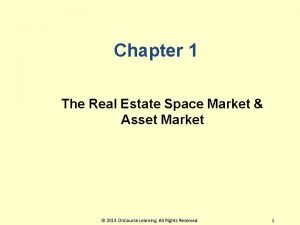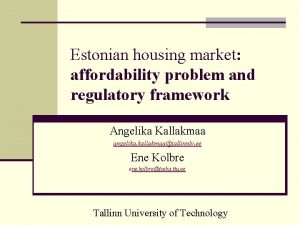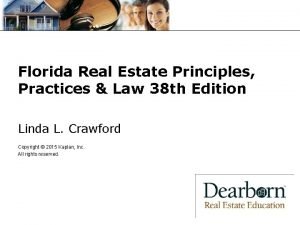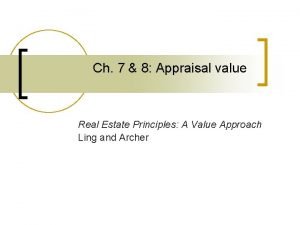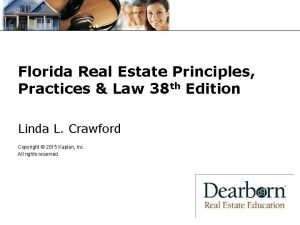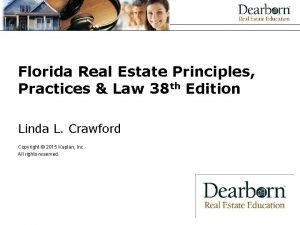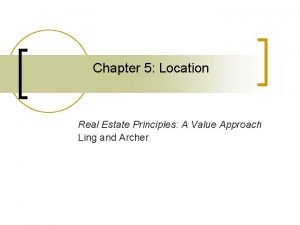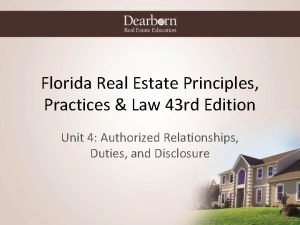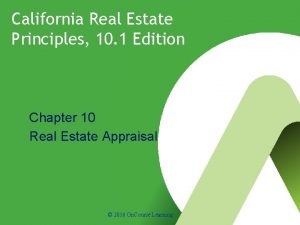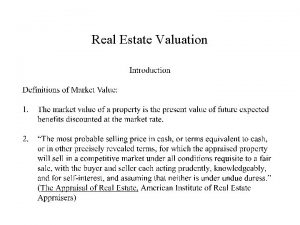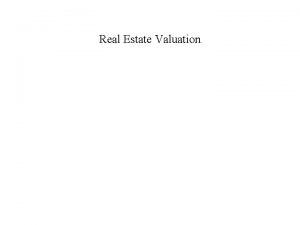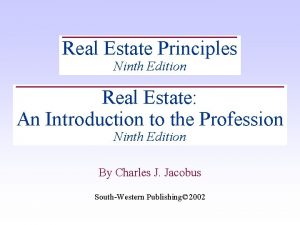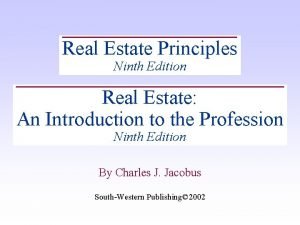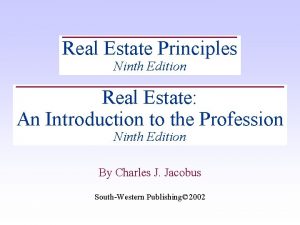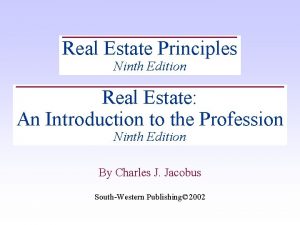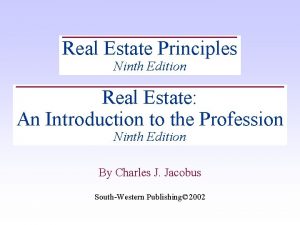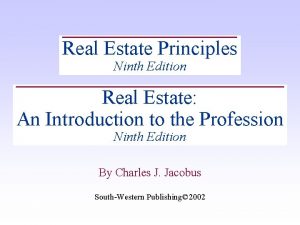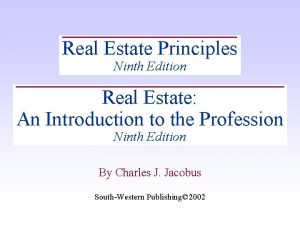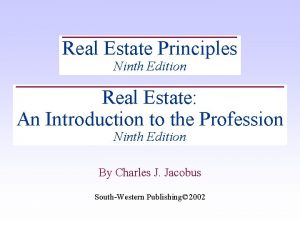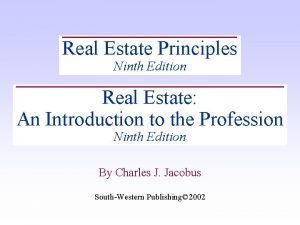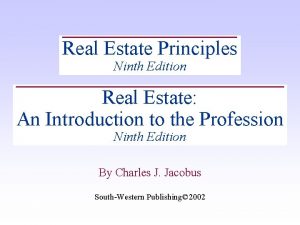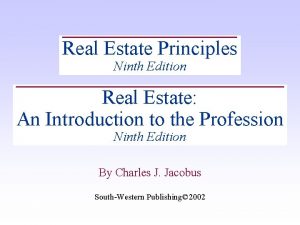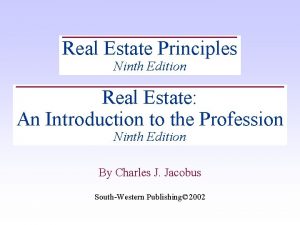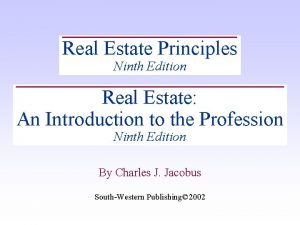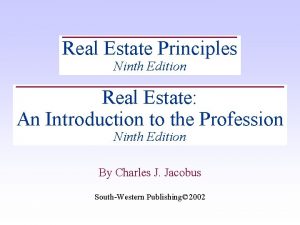Chapter 5 Residential Market Analysis Real Estate Principles























- Slides: 23

Chapter 5 Residential Market Analysis “Real Estate Principles for the New Economy”: Norman G. Miller and David M. Geltner

Major Topics ¨ Demand drivers for home ownership ¨ Drivers of long and short term owner occupied housing market ¨ The decision to buy or rent ¨ The cost of home ownership ¨ Calculating what you can afford ¨ How the government supports mortgage lending and discourages discrimination ¨ Age and ownership ¨ Simple models of multifamily housing analysis ¨ The dynamics of rental housing market ¨ Trends in residential housing “Real Estate Principles for the New Economy”: Norman G. Miller and David M. Geltner

Introduction ¨ Residential structures account for 24% of value of all assets owned in U. S. ¨ Each generation desires bigger and better homes ¨ Average new housing is 25% bigger than what it was fifty years ago ¨ Home ownership rate has been rising steadily ¨ 64% in 1990 to 68% in 2002 “Real Estate Principles for the New Economy”: Norman G. Miller and David M. Geltner

Is Home Ownership a Right? ¨ Home ownership is thought to provide not only shelter and comfort but also some degree of financial security, and in some cases significant investment returns as well ¨ In a capitalistic system, no one has a “right to home ownership”, but safe and healthy housing for all citizens is considered a national priority – much like full employment “Real Estate Principles for the New Economy”: Norman G. Miller and David M. Geltner

Long Term Demand for Housing ¨ Demand for housing is a function of: ¨ Household growth rate ¨ General economic productivity ¨ Indicators of housing demand: ¨ Population ¨ Household sizes “Real Estate Principles for the New Economy”: Norman G. Miller and David M. Geltner

Long Term Demand for Housing (Contd. ) ¨ What influences Household Size? ¨ People are living longer – more of life spent without children at home ¨ Women outlive men – more widowed single households ¨ People are having fewer children ¨ More women participating in the workforce ¨ Divorce rate in the U. S. has been steadily rising “Real Estate Principles for the New Economy”: Norman G. Miller and David M. Geltner

Regional Demand for Housing Factors leading to absolute and relative growth in the number of households: ¨ Size of existing population ¨ Job Growth (especially within export sector) ¨ Overall Quality of Life “Real Estate Principles for the New Economy”: Norman G. Miller and David M. Geltner

Short Term Demand for Housing ¨ Dominant factors for short term demand: ¨ Mortgage interest rates ¨ Seasonality (climate, schools, holidays) “Real Estate Principles for the New Economy”: Norman G. Miller and David M. Geltner

The Buying vs. Renting Decision Economic Factors ¨ ¨ ¨ Capital constraints Expected tenure Income tax rate Tax laws for capital gains Mortgage rates & Financing programs Investment aspects (expected appreciation) ¨ Budgeting risk “Real Estate Principles for the New Economy”: Norman G. Miller and David M. Geltner

The Buying vs. Renting Decision (Contd. ) Psychological Factors ¨ Control over housing unit (design, appearance) ¨ Long term housing aspirations ¨ Ego satisfaction and utility of ownership “Real Estate Principles for the New Economy”: Norman G. Miller and David M. Geltner

How Much Home can one Afford? ¨ Sources of capital : Equity or Debt ¨ The before tax costs of owning a home include: ¨ Mortgage payments (most significant) ¨ Property taxes ¨ Property insurance ¨ Utilities ¨ Maintenance “Real Estate Principles for the New Economy”: Norman G. Miller and David M. Geltner

Federal Government Assistance ¨ VA ¨ FHA ¨ GNMA ¨ FHLMC “Real Estate Principles for the New Economy”: Norman G. Miller and David M. Geltner

Housing Products and Demand Segments Product Segmentation ¨ Single family detached ¨ Single family attached (usually condominium) ¨ Manufactured housing ¨ Mobile homes “Real Estate Principles for the New Economy”: Norman G. Miller and David M. Geltner

Analysis of Housing Market: Demand ¨ Simple Population and Household Trending ¨ Estimating demand based on employment growth “Real Estate Principles for the New Economy”: Norman G. Miller and David M. Geltner

Analysis of Housing Market: Supply Developer Monitoring ¨ Estimating the supply coming online is very difficult due to large number of developers of varying sizes ¨ It is very easy to supply too much housing and the housing market tends to move in cycles “Real Estate Principles for the New Economy”: Norman G. Miller and David M. Geltner

The Integrated Development Model: Short Term Modeling of Demand & Supply ¨ Apart from aggregate market analysis, developers use a simple model: ¨ “Keep building units as long as they sell or rent” ¨ Short term indicators are: ¨ Occupancy rates (conversely vacancy rates) ¨ Waiting lists ¨ Recent rental growth rates “Real Estate Principles for the New Economy”: Norman G. Miller and David M. Geltner

Housing Market Dynamics: Searching for Equilibriums ¨ Supply and Demand are bought together by “price” ¨ Economic principles to understand housing markets “Real Estate Principles for the New Economy”: Norman G. Miller and David M. Geltner

Patterns of Possible Rental Housing Market Changes ¨ Two general processes which bring a market back to long run equilibrium after a change in demand or supply: 1. Demand increases or supply is reduced 2. Demand is reduced or supply increases beyond equilibrium levels “Real Estate Principles for the New Economy”: Norman G. Miller and David M. Geltner

Demand Increase or Supply Reduction Rent D 2 D 1 1 st S 1 S 2 2 nd Q 1 Q 2 Supply “Real Estate Principles for the New Economy”: Norman G. Miller and David M. Geltner

Supply Over-shoots Demand S 1 Rent 1 st D 1 S 2 2 nd 1 st 2 nd Q 1 And Q 3 Q 2 Supply “Real Estate Principles for the New Economy”: Norman G. Miller and David M. Geltner

Senior Housing Options Seniors’ location preference: ¨ Warmer Climate ¨ Low income tax ¨ Close to prior housing location Senior Housing Options: ¨ Active Adult Community Independent Living Housing ¨ Congregate Housing with Assistance and Nursing ¨ Skilled Nursing Homes ¨ Alzheimer’s Specialized Care Centers ¨ Hospice Centers “Real Estate Principles for the New Economy”: Norman G. Miller and David M. Geltner

Trends in Housing Market ¨ New economy has increased the population of ¨ ¨ ¨ ¨ mobile workers Mobile worker travels frequently and more wealth and higher income More and more households own second homes today If this trends continue people will have three or four homes strategically located for business or pleasure Internet has put pressure on brokerage costs and this may result in increased buy and sell transactions Senior population has increased much faster and housing suiting their needs will have good demand A permanent renter market is also becoming more common Apartments are getting bigger and better “Real Estate Principles for the New Economy”: Norman G. Miller and David M. Geltner

END “Real Estate Principles for the New Economy”: Norman G. Miller and David M. Geltner
 Greece property market
Greece property market Space market in real estate
Space market in real estate Bhubaneswar real estate market
Bhubaneswar real estate market Gotbar
Gotbar Estonian real estate market
Estonian real estate market Estonian real estate market
Estonian real estate market Southpoint village apartments fishers indiana
Southpoint village apartments fishers indiana Florida real estate principles practices & law
Florida real estate principles practices & law Florida real estate principles practices & law 43rd edition
Florida real estate principles practices & law 43rd edition Income approach appraisal
Income approach appraisal Florida real estate principles practices
Florida real estate principles practices Florida real estate principles practices
Florida real estate principles practices Rent real estate principles a value approach
Rent real estate principles a value approach Florida real estate principles practices & law 43rd edition
Florida real estate principles practices & law 43rd edition Florida real estate principles practices
Florida real estate principles practices Rent real estate principles a value approach
Rent real estate principles a value approach Financial investment analysis
Financial investment analysis Residential ventilation fans market
Residential ventilation fans market Chapter 11 real estate and other investments
Chapter 11 real estate and other investments Market leader challenger follower nicher examples
Market leader challenger follower nicher examples Positioning and targeting
Positioning and targeting Real estate sales pitch sample
Real estate sales pitch sample Mofir real estate
Mofir real estate Real estate stakeholders
Real estate stakeholders

